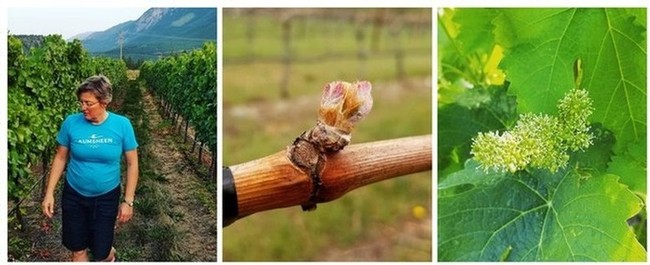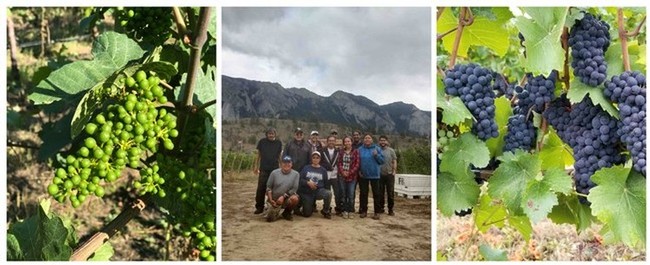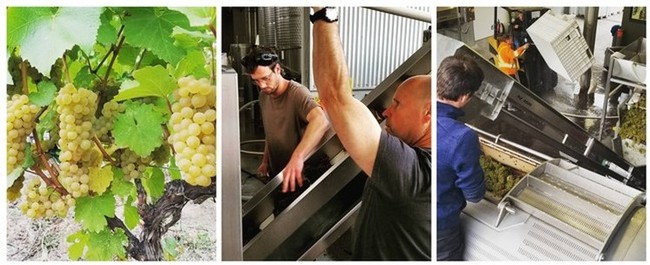2019 Vintage Report
With 10 years of growing grapes in our vineyard in Lillooet, we have seen a variety of weather patterns over the years. The weather tends to move in cycles with hot or cooler seasons, dry or wet seasons, years with fire or smoke, and seasons with more or less sunshine. When farming, we try our best to anticipate and ultimately adapt to variations in seasonal weather. We look at trends, but as farmers, we have to be prepared for whatever we are given. The seasonal variations we see each year create opportunities and challenges for each vintage and make our wines more interesting to taste and compare.
While our 2019 growing season started off average, the weather during harvest was challenging. We had a warm and dry spring with virtually no rain from February through May. Bud break in most of our blocks occurred at the end of April, which is average for this region. The vineyard developed well during the early summer with relatively early development in the summer months. During the summer, the temperatures were high, but not extraordinary, and we were fortunate not to have any smoky skies. We had a wet summer with more rain than normal. In September, temperatures cooled, and an early frost came on October 9th which caught us by surprise. The average temperature this season was well above the long-term average, similar to 2018, yet not as high as we saw in 2017. Overall, the quality of the fruit from this vintage was very good.

In 2019 we welcomed a new vineyard manager and a new winemaker to our Fort Berens team. Andrew Stone joined the team as our new vineyard manager, and James Cambridge joined us as our new (and returning) winemaker. Together they brought new enthusiasm, experience, and techniques. Andrew and James worked very well together to strategize, plan and execute each step of the vintage, from the growing, harvesting and winemaking process.
Andrew drew up a specific plan for each block in our vineyard based on the grapes being grown for specific wines. For each grape, there was a plan that covered crop load, pruning strategy, training requirements, and canopy management. The plan called for our vineyard team to pay special attention to the blocks that were identified for the Reserve Wines. Under Andrew’s leadership, our vineyard team was empowered to take on more roles and responsibilities. Some team members specialized in tractor work, others in irrigation and spraying. He implemented a new fertilization and irrigation program for better consistency, with the goal being to give the vines what they need at the right time.
James uses a minimalist approach to the winemaking process to allow the fruit to speak for itself. He wants the wine to highlight the specific qualities of each vintage. The approach that James takes to winemaking is characterized by patience. He aims to take sufficient time for each step in the winemaking process: cold soaks prior to fermentation, slow ferments for whites by keeping temperatures low, longer post-maceration soaks for the reds after fermentation, and longer barrel aging to fully develop the wines he crafts. As we taste the wines throughout the aging process, we see that this labour-intensive winemaking practice is well worth it.
With a new, seasoned team in place, this vintage was highly anticipated. At this point, the wines are developing nicely and are well on their way to meet the higher expectations we have for them.

In terms of yield, the vintage turned out to be in line with our plans. More importantly, James was pleased with the quality of the grapes that came in from our Dry Creek Vineyard. We harvested about 82 tonnes of Pinot Noir, Chardonnay, Riesling, Pinot Gris, Cabernet Franc and Merlot from Dry Creek Vineyard. Another 75 tonnes came from our contract growers in the Lillooet area and from growers in the Okanagan and Similkameen.
In our plans for 2019, we decided that we would allocate all of the estate grown Pinot Noir grapes to our very popular Rosé. We encouraged the vigour of the vines with generous irrigation and limited shoot thinning. The grapes were harvested earlier in the season, at lower sugar levels. We are pleased with the results of this targeted approach, as it improved both the quality and quantity of the Rosé. We are proud to say that this years’ Rosé 2019 will be 100% estate grown and therefore Lillooet VQA, and we will have more Rosé available than in previous years.
The Chardonnay from our vineyard was very clean and flavourful. Grapes from specific blocks in the vineyard allocated for the White Gold were whole-cluster pressed and 100% barrel fermented in a mix of new and neutral barrels. James used several different yeast strains to add complexity to the Chardonnay. Currently, the lees are being stirred every 2 weeks while the wine ages in French oak barrels. Chardonnay from the Similkameen will be combined with some of our estate fruit for the classic Chardonnay - 20% has been barrel fermented and 80% in stainless steel.
The Riesling vines in our Dry Creek Vineyard had a tough year. Unlike other varietals in the vineyard, Riesling suffered from significant bud damage. Bud break was much later in relation to other varietals and our normal average. We saw buds emerge from the trunk, the graft and other unusual spots on the plants. We suspect that cool weather patterns in late winter and early spring affected the buds and delayed bud break. The yield from our Riesling block was very small. Small yields typically excel in flavours, concentration, and complexity. At this stage, we have decided to allocate the entire volume to the Riesling Reserve as we are thrilled with the quality. Fortunately, the vines were not damaged and bounced back through the season. Therefore, we anticipate that with a good growing season in 2020, we will have a much larger crop of Riesling in 2020. We brought in Riesling grapes from Vernon, Oliver, and the Similkameen, which were fermented separately and will be combined to produce our Riesling 2019. We will also have a small quantity of Dry Riesling made with grapes from the Okanagan.

As the weather cooled in September, we had to wait a bit for the ripening and harvesting of the Pinot Gris, Cabernet Franc, and Merlot. When the frost came on October 9th, the vines lost their leaves and the grapes stopped developing sugars. Luckily, most varietals already had satisfactory levels of sugar and phenolics. The grapes were harvested as space opened up in the cellar. Some of the fruit was left a little longer, which dried the fruit out a bit and raised the sugar level, which will make for higher intensity and bolder reds. James used the same approach for processing all of our reds this year. The process started with a cold soak for 2 - 5 days prior to initiating fermentation. After the completion of fermentation, the wine was left for post-ferment maceration for 2 weeks. The wines are aging currently in new French and American oak barrels.
We have high expectations of both the red and white wines from the 2019 vintage. The white wines are showing to be well balanced with good acidity. They are very fresh with lovely fruit flavours. The Rosé has great colour and will be fresh without a lot of residual sugar. Many of the red wine grapes were brought in a little bit dried out, which means they will have increased intensity and will be more full-bodied. They were cold-soaked which resulted in a deeper colour, and in some cases more complex flavour. These wines will develop substantially over the longer-than-usual barrel aging period; 12 months for the classic reds and about 16 - 18 months for the reserve reds.
We are also thrilled to report that we completed planting the Red Rock Vineyard in May of 2019. A lot of time was spent making sure the small and growing vines are healthy as they develop. The Red Rock Vineyard now has 6 acres of Merlot, 5 Acres of Cabernet Franc, 3.5 acres of Riesling, 2 acres of Cabernet Sauvignon and 1 acre of Gruner Veltliner. This brings our estate vineyard to 38 planted acres. Our vineyard expansion means that in the years ahead, there will be more Lillooet-grown grapes, and we will have a broader selection of grapes to work with in Lillooet.
When we welcomed James back to the team as our winemaker, one of our goals was to have more consistency in our vintages. This vintage is very much on target. Stylistically, we are happy with this vintage. We couldn’t be more excited to share the 2019 vintage with you. Thank you for waiting with us in anticipation of the release of our wines this coming year.
